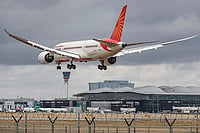MORE than halfway through the game, can you scrap all that has happened till now and announce new rules? That's what the Union Communications Ministry has done with the basic telephone services privatisation process. With the ministry changing colours faster than a chameleon, the whole affair is suddenly mired in confusion. First it announced that no company would be allowed more than three A and B circles—the most lucrative regions—to wire up. Then on November 11, a full 72 days after the tender was opened, the Tender Evaluation Committee (TEC) of the Department of Telecommunication (DoT) rejected the highest bids of 10 operators, throwing the door open for retendering. New rules, new game.
Incensed transnationals mutter off-the-record about dropping out of the process. Dark accusations float about the ministry going out of its way to favour one particular Indian company, and letting the greed for higher license fees hijack privatisation. All concerned raise serious doubts about the country being able to meet its goal of setting up high-speed telecom services by 1997. And observers fear that, coming close on the heels of the Enron imbroglio, the telecom muddle may undermine foreign investors' con-fidence in India's liberalisation programme itself.
The TEC, in its report, has said that it found the offers "far below the reasonable level." Only the nine bids of Himachal Futuristic Communications Ltd (HFCL), amounting to a whopping Rs 85,000 crore, and the Rs 13,909 crore offer of Hughes Ispat in Maharashtra have been found acceptable. But there's a cap of three A and B circles per bidder. So, assuming Hughes Ispat takes Maharashtra, and HFCL three A and B, and one C circle, in effect, the TEC's decision means that 15 of the 20 basic telephone circles are up for resale, and back to square one.
For telecom companies still trying to cobble together new business plans after the capping decision, the rejection slips have come like a bolt from the blue. "Each time we think the worst is over, the ministry fires another missile," complains an executive from a US telecom major.
There's nothing wrong in exploring the market for more revenue, contends Telecom Commission Chairman R.K. Takkar, frank and outspoken as usual. "Don't you go to three or four shops when you want to buy something?" he argues. "Our focus is to test the market again, as the prices offered by the bidding telecom companies in the first round is not good enough."
The re-bidding will take place in two stages, reveals Takkar. In the first stage, 15 shortlisted telecom companies, barring HFCL already covered by the cap, will be invited to rebid for the 10 circles whose highest bids were found to be below the ministry's expectations. In the second stage, the five circles vacated by HFCL would be open for bidding. HFCL executive vice-chairman Mahendra Nahata says HFCL and its partners, Israel-based Beseq and Thailand-based Shinawatra, have decided to opt for A circle Delhi (licence fee bid Rs 15,085 crore) and B circle Haryana (bid Rs 4,060 crore). Industry and DoT sources say the combine is likely to also take B circle UP west (bid Rs 6,580 crore) and C circle Orissa (bid Rs 2,065 crore), though Nahata says the alliance is still to decide on these two.
Whichever five circles HFCL vacates, other companies which had bid for these, says Takkar, will be invited to match HFCL's bids. If these companies fail to match the HFCL figures, the circles will be thrown open to all 15 shortlisted companies. But few agree with either the Government's methods or its expectations. And their voices are strident:
The 15 shortlisted companies are being sent letters, stating that their bids have not been accepted and inviting them to submit fresh offers. To help prospective bidders, the letters will contain the reserve price/benchmark decided by the ministry for each circle—the minimum licence fee for each of the 10 basic circles open to re-bidding in the first stage. This works out to 7.5 per cent of the revenue potential in each circle. This potential for each circle has been worked out by taking into account the average projections made by the Telecom Commission and private bidders, existing tariff levels, expected inflation over the next 15 years and historical data of the actual costs and earnings of the DoT and Mahanagar Telephone Nigam Ltd (MTNL).
All that is fine, say the bidders, but the Government definitely should not have reneged on the methodology it itself decided. "The introduction of the concept of a reasonable licence fee at this late stage when the bids have already been opened and assessed is definitely an afterthought," says Vijai Kapur, chairman of the Confederation of Indian Industry's telecom committee. This has thrown the privatisation process off gear: "It is at a critical danger mark," he warns.
The ministry should have calculated the real potential of the telecom circles and set a reserve price at the outset, says Athreya. To impose new conditions on bidders now is"not conducive to trust," he points out. Anyway, the objective of the National Telecom Policy is not to maximise revenue through bids from private operators, says Athreya, but to provide within a given time frame (1997) high-speed telecom services to bolster the economy and speed exports. In fact, the licence fees from private operators should not ideally go to the DoT but be used to develop the social infrastructure.
But if the ministry is to be believed, everything is as hunky-dory as ever. For instance, contrary to all available evidence, it affirms that the confidence of telecom companies in the ministry is not shaken at all. It claims that it is upbeat about players meeting the DoT's expectations of the reserve prices, and even matching HFCL's bids in the five freed circles. Says Takkar confidently: "You and I should not be surprised if we meet our goals." But maximisation of revenue, he insists, is not one of the primary goals. The principal focus in any tendering—including the coming round—is "to arrive at a price which is mutually acceptable to the seller and buyer," he avers.
So too about the delay that all the changed rules of the game will cause. The Telecom Commission chairman reckons that the whole rebidding process would be over within eight to 10 weeks. Nahata of HFCL is even more opti-six weeks. "Give us the licences and we will have our basic telephone services in place within six to 12 months," he boasts.
Every Indian will definitely be hoping that Nahata is proved correct, but as things stand currently, the ministry's volte faces are sending all the wrong signals, and not only to the world telecom industry. "This has hit the confidence of investors both domestic and foreign," says Athreya. "Even foreign investors exploring other infrastructure projects are likely to doubt to some extent India's maturity as a safe destination for investment."
And Chandrasekhar of BPL-US West minces no words. "The ministry's conclusion that the bid offers are not reasonable is irrational and smacks of adhocism," he accuses. "This same adhocism is seen again and again and the entire liberalisation process in telecom and elsewhere is being derailed and compromised because there is not enough broad-based intellectual thinking going into the initiation of these kinds of liberalisation."
As Outlook goes to press, speculation is rife. Is this a desperate bid by the Government to cut the fiscal deficit? Or, with the Lok Sabha elections barely five months away, is it possible that the Government is playing the swadeshi card and probably trying to defer the entire telecom privatisation process? Chandrasekhar says that though he is "extremely confused" about the rationale the Government is using in judging bids, he would not hazard a guess on its intentions.
In fact, given the current reluctance of bidders to raise their stakes to the DoT’s expectancy levels, a third round of bidding will not be such a farfetched possibility. Athreya feels retendering could take six months or even more. There is thus the danger of a new government not continuing with the same telecom privatisation policy or delaying it by two to three years, he adds. But even if the process is over by the polls, there are enough dark clouds to that silver lining. "Our worst fear is that licences will be awarded close to the elections," says a senior executive of a foreign telecom major, on condition of anonymity. "What stops opposition parties from putting re-evaluation of telephone bids on their agenda?" Just like they did with Enron.


























